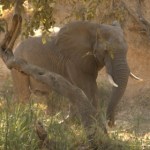Elephants
It wasn't a mammoth, it was a mastodon. But it was still a big hairy elephant featured at the climax-end of the main exhibit hall in the New York State museum. And it was an exhibit to end all exhibits. The New York State Museum, during its heyday, was world class, and the hall of evolution, which seemed old enough to have involved Darwin himself as a consultant, featured the reconstructed skeleton as well as a fur-covered version, of the creature discovered in a kettle only a few miles away. That exhibit, along with a dozen other spectacular exhibits that to my knowledge have not been…
Everyone knows that there are two kinds of elephants in this world: Asian and African. The Asian is the only one that can be trained and the African ones live in harmony with their environment until hunters come by and shoot them. Scratch a little deeper, and the African bush elephant lives by destroying its environment and moving on to new areas, where it destroys that environment, cycling back to the original region over generational time; Both African and Asian elephants can be trained; and there are three, not two species of elephant in this world: Asian, African Bush, and African…
What information is contained in the call of a mammal? Some calls might reflect the internal emotional state of the animal, like fear or anxiety, or they can refer to an external object, agent, or event, like the presence of a predator. Rhesus monkeys, lemurs, baboons, and guinea pigs, for example, will produce calls when separated from their conspecifics or in the presence of a stranger. Howler monkeys produce specific alarm calls for avian predators, even when they have never encountered an avian predator for several generations. Vervet monkeys produce different calls in response to…
At first glance, the African elephant doesn't look like it has much in common with us humans. We support around 70-80 kg of weight on two legs, while it carries around four to six tonnes on four. We grasp objects with opposable thumbs, while it uses its trunk. We need axes and chainsaws to knock down a tree, but it can just use its head. Yet among these differences, there is common ground. We're both long-lived animals with rich social lives. And we have very, very large brains (well, mostly).
But all that intelligence doesn't come cheaply. Large brains are gas-guzzling organs and they need…
This is a bull elephant firmly establishing why it is he, and not the lion, who is king of beasts. The elephant's penis is not only massive but prehensile. As we watched in baffled amusement (and the faintest tinge of inadequacy), he used his penis to prop himself up (as in the photo), swat flies from his side and scratch himself on his stomach. David Attenborough never showed us that...
There's good reason for elephants to have prehensile penises. It's hard enough for a six-tonne animal to get into the right position for sex, let alone having to do the rhythmic thrusting that's required. So…
You really must give up seafood from the ocean. Or at least, there is an argument that says this, and you can read it here.
Wolverines. I once saw a wolverine in a state that was known to not have wolverines anymore. That was a long time ago and I think they are recognized as having returned to those forests. Now, we have wolverines in Colorado for the first time since 1919. I am shocked and amazed that wolverines had been extirpated from Colorado.
All ivory is bad. Antique, modern, you name it. If you buy ivory, you are poaching an African Elephant. I assume you knew this already,…
In 1833, Darwin spent a fair amount of time on the East Coast of South America, including in the Pampas, where he had access to abundant fossil material. Here I'd like to examine his writings about some of the megafauna, including Toxodon, Mastodon, and horses, and his further considerations of biogeography and evolution.
reposted
In the vicinity of Rio Tercero...
Hearing ... of the remains of one of the old giants, which a man told me he had seen on the banks of the Parana, I procured a canoe, and proceeded to the place. Two groups of immense bones projected in bold relief from the…
Moving to a new area can be a daunting experience, especially if you don't know anyone. At first, you might cling to any friends who do live nearby but eventually, you meet new people and start to integrate. As it is with humans, so it is with elephants.
Noa Pinter-Wollman and colleagues from the University of California, Davis wanted to study how African elephants behave when they move to new environments. This happens quite naturally as elephants live in dynamic societies where small family groups continuously merge with, and separate from, each other. But they also face new territories…
This particular elephant was one of the nicest elephants I've ever met.
click for a larger picture
I was leading a tour group in the vicinity of the Kruger National Park in South Africa. The local guide suggested that we could take a walk along a particular trail, as long as vehicles stayed near by in case of trouble. This is a pretty standard thing to do with tourists in Africa. They get tired of being in vehicles all the time. If you know an area well enough, and have the vehicles near by, you can walk around a while. This gives us a chance to show people things like plants and insects…
The genome of the extinct woolley mammoth (Mammuthus primigenius) has been sequenced, and reported in Nature. This confirms that elephant genomes are large, like the elephants themselves. It confirms previously proposed relationships amongst the elephants (see phylogeny below) and refines the known phylogeny. Interpopulation differences among mammoths were also demonstrated.
Here's the phylogeny:
Comparison of phylogenies of elephants and hominoids. "We show estimated divergence times, that is, times to the common ancestor averaged across autosomes (see Methods). Red circles at the…
I have had this experience. I've traveled literally hundreds of kilometers by foot together with Efe (Pygmy) hunters in the Ituri Forest. We see very few animals. The few we do see are attacked, killed, and eaten. Well, a lot of them actually get away, but that is the idea.
But I've also traveled many kilometers (not as many) alone. I would see many animals, and yes, they would run (or climb or whatever) away, but not as desperately. They knew I was not really one of the hunters, although I tried my best to look tough and hungry.
Of course, when I use the word "animal" here I mean…
That elephants have an aquatic ancestry has been suspected for some time now. Moreover, the idea of elephant aquatic origins and elephant origins in general is part of a growing realization that many of the world's aquatic mammals originated in a couple of regions of Africa that were for a very long time enormous inland seas (but that is another story I won't cover here).
The earlier evidence came from observation of the ontogeny of the kidneys in elephants, during which the kidneys take on the characteristics that are found in aquatic mammals generally. That research was published in 1999…
Ever since 3,599 years ago humans have been asking the question "Why did our furry elephant go extinct?"
What caused the woolly mammoth's (not to be confused with the also-woolly mastodon) extinction? Climate warming in the Holocene might have driven the extinction of this cold-adapted species, yet the species had survived previous warming periods, suggesting that the more-plausible cause was human expansion.
The woolly mammoth went extinct less than four thousand years ago. The bones of miniaturized woolly mammoths have been found in Siberia dating to about 3,600 years ago. Indeed,…
I have had this experience. I've traveled literally hundreds of kilometers by foot together with Efe (Pygmy) hunters in the Ituri Forest. We see very few animals. The few we do see are attacked, killed, and eaten. Well, a lot of them actually get away, but that is the idea.
But I've also traveled many kilometers (not as many) alone. I would see many animals, and yes, they would run (or climb or whatever) away, but not as desperately. They knew I was not really one of the hunters, although I tried my best to look tough and hungry.
Of course, when I use the word "animal" here I mean…
Hunting Wolves; Killing Elephants
The Bush administration on Thursday announced an end to federal protection for gray wolves in Montana, Wyoming and Idaho, concluding that the wolves were reproductively robust enough to survive.
"Wolves are back," said Lynn Scarlett, the deputy secretary of the Department of the Interior, in a telephone conference call with reporters. "Gray wolves in the northern Rocky Mountains are thriving and no longer need
A coalition of wildlife and environmental groups dismissed the government's claims and announced plans for a lawsuit to reverse the decision, which is…
You need:
a pair of binoculars
a pair of tweezers
a bottle
a cork
an elephant call.
First you call the elephants. Then, when they are close but not too close, you look at them with the binoculars backwards. Remember, backwards. That way they will be very small. Then, you pick them up one by one with the tweezers, and put them in the jar.
Don't forget to cork the jar.
Don't have an elephant call? You can make one yourself with spare medical supplies laying around the house:
Elephant Call
I have had this experience. I've traveled literally hundreds of kilometers by foot together with Efe (Pygmy) hunters in the Ituri Forest. We see very few animals. The few we do see are attacked, killed, and eaten. Well, a lot of them actually get away, but that is the idea.
But I've also traveled many kilometers (not as many) alone. I would see many animals, and yes, they would run (or climb or whatever) away, but not as desperately. They knew I was not really one of the hunters, although I tried my best to look tough and hungry.
Of course, when I use the word "animal" here I mean…
As reported in the AP, six Asiatic wild elephants were electrocuted after drinking alcohol in northeast India and going berserk. Apparently the animals have developed a taste for rice beer, fermented by farmers in plastic drums, and come looking for it when they enter villages. Perhaps taking a cue from the aforementioned self-immolating squirrel, the elephants then uprooted a utility pole and, sadly, zapped themselves. "It's great to have such a huge number of elephants, but the increasing man-elephant conflict following the shrinkage in their habitat due to the growing human population is…
tags: researchblogging.org, elephant, Africanized honeybees, maize, Africa
As humans compete with wildlife for ever smaller areas, the likelihood for conflict between them grows. Unfortunately, this is a problem for the endangered African elephants, whose love for human crops has caused grief for both elephants and people. However, some creative research by a team from Oxford University has suggested a possible solution to the "elephant problem."
Elephants are not afraid of mice, but new research shows that they definitely fear the sound of bees because the angry insects can inflict painful…


